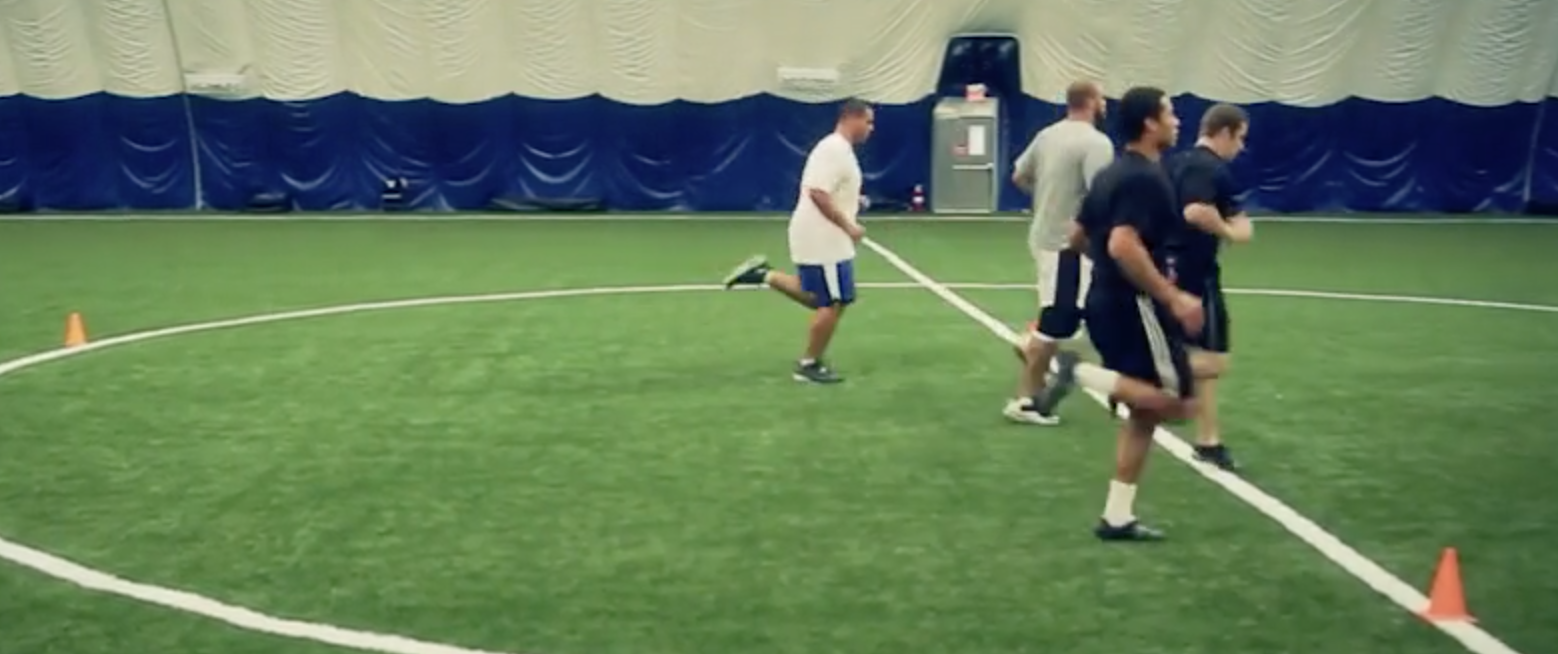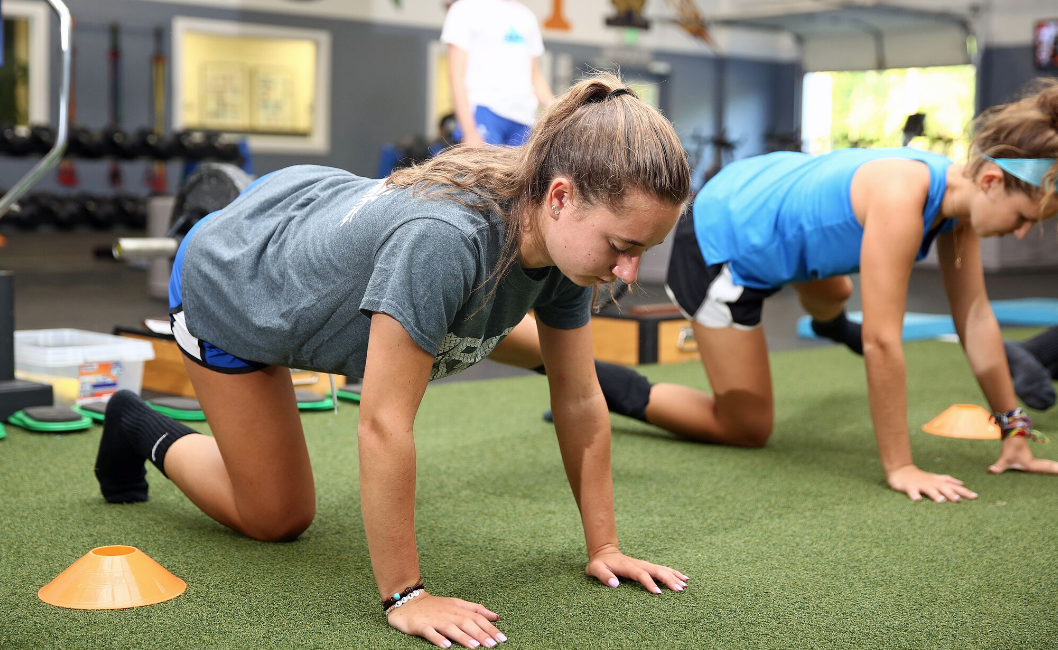Warm It Up
By: Patrick Beith

There still seems to be many questions on what an effective warm up is and how it should all be put together. I want to share with you what we use at Athletes’ Acceleration.
If you want your athletes to be able to perform at a high level in their sport, a proper warm-up is crucial. Not only is it our goal to get our athletes ready to compete and perform to their full potential, our role as coaches is first and foremost to prevent injuries. There is nothing more critical in reducing the incidence of injury then putting our athletes through a well structured warm-up program.
What does a properly designed warm-up program mean? Running fast and performing explosive movements are extremely complicated activities from a neuromuscular standpoint, so there are certain things to consider and rules to follow.
Slow to fast, simple to complex
Those are the words to live by when creating your warm-up routine. We want slow, controlled, easy movements to get athletes ready to perform at full speed in practice or a game. As you progress through the warm-up, your athletes will make a simple transition to the more complicated and faster movements. We want to stimulate and create the intensity of the upcoming practice or competition by the end of the warm-up.
A good warm-up should take at least 20 minutes to complete in order to raise the core temperature and really get the muscles fired up and ready to go. We always tell our athletes that their warm-up should have made them break a sweat. If they aren’t lightly sweating and slightly out of breath as the complete their warm up routine, then they are not ready to compete. Too often, I have seen some athletes just going through the motions and they have not prepared themselves to do anything, let alone sprint. This is where injuries happen. Your athletes have to know the importance of the warm-up and how doing it properly will help improve their performance.
We do not want our athletes to be too fast too soon, and this is where a properly designed warm-up comes into play. There is a progression of movements that you must follow in order to get the most out of your warm-up. The purpose of the warm-up is to loosen and bring blood flow to the muscles, take the body through the ranges of motion they are going to compete in, and match the intensity of the competition the body is about to encounter.
The flow created from your warm-up program is going to set the tone for the rest of your workout or game.
Should every workout have the same warm-up routine?
No. When preparing for practice we must take into consideration what our goal is for the day. Is it a speed/power day, a recovery day, a light day (like the day before a game)? how do your athletes feel? (stiff, sore), etc. Different warm-up programs and volumes can be used dependant on all of these issues. However, a speed/power day warm-up is going to be similar each time it is performed as there are some core drills that should be used on that day (as you will see below).
Athletes do get bored with running the same warm-up every day and you need to take into account possible staleness. When athletes get bored of certain exercises they get lazy and their technique suffers. That being said, try not to add too many new exercises at once. Although we do not want the athletes to get bored and we want to keep the warm-up interesting, we always want them to perform each drill with perfect technique. Make sure your athletes can do the drills properly before adding in new exercises.
Before I show you some sample workouts, I need to address static stretching. Athletes come to us with cold muscles that are not ready to be explosive, so to static stretch right before we want them to perform at a high intensity does not make any sense. Static stretching right before an activity will definitely decrease power output, and that is why I try not to use it before most practices.
So can static stretching be used?
Yes… well sort of. So, I am on record saying that I do not like to static stretch before a speed work out, however, I also do not believe that static stretching is the devil as some coaches have been acting like it is. All I am saying is, I do not think static stretching is ideal to use right before a practice or game.
There are coaches on some teams that want their athletes to static stretch before the practice and there is nothing you can do about it; that’s the way it is. You can’t change some coaches’ minds, so we need to learn how to work with them to achieve the same goal of helping the athletes become successful. Adding a dynamic warm-up right after static stretching will be of great benefit. If those athletes are performing a dynamic warm up routine right after the static stretching, the issue of decreased power output will be less of a problem. The amount of time it takes to perform the dynamic warm-up after the completion of the static stretching will minimize problems and help get the athlete closer to becoming ready to compete at full speed. So, unless your athletes are performing a vertical jump or running a full sprint right after static stretching, without a dynamic warm-up in between efforts, then you should be all set and can get away with static stretching before practice (although I do not recommend it).
What if your athletes are sore? Wouldn’t you want them to static stretch?
Some coaches like to have their athlete’s static stretch before practice if they are sore. If my athlete’s muscles are sore, then I will have them go through a light workout (not performing anything explosive) and static stretch at the end of the workout. If you have sore athletes and you have them running full speed or working on a lot of power movements then you are asking for an injury. In these circumstances it will take the athlete a lot longer to recover. So, simply put, we would not have our athlete’s static stretch on a speed/power workout day because they wouldn’t be performing a speed/power workout if they are really sore.

Now, let’s get into some examples. Here are some samples of warm-up routines that we use:
Speed/Power Day Dynamic Warm-up
Have your athletes jog for 5-10 minutes. Have them jog a lap then skip for a lap around a track or football field (or comparable sized space).
– Pushups – x 10
– Stationary Squat – x 20
– Stationary Lunge – front x 5 each, lateral – x 5 each
– Trail Leg (circles – on all fours) – x 15 each
– High knee walk (hug knee) – x 10 each leg
– Jog back to start
– Lateral lunge walk (w/ inner thigh) x 10 each leg
– Jog back
– Lateral Lunge x 10 each leg
– Lateral Skip right – x 30 yards
– Front leg swings – x 10 each leg
– Lateral Skip left – 30 yards
– Lateral leg swings – x 10 each leg
– Skip 50 yards
– Backwards run – 2 x 30 yards
– 'A' skip – 3 x 15 yards
– Walk back
– 'A' run – 3 x 20 yards
– Walk back
– Skip for height – 1 x 20 yards
– Walk back
– Fast leg – 2 x 30 yards (Right leg, Left leg, Alternate)
– Walk back
– Accelerations – 4 x 40 yards (1@75%, 1@ 85, 1@95%, 1@100%)
On a speed day, we use a similar warm-up program as we would on a game or competition day. We want our athletes to practice like they compete and this is especially the case for your speed/power day warm-up. When they perform their speed day warm-up, they know that they need to be ready to go full speed and be able to compete at the highest level. Also, we don’t want our athletes to be confused by using 100 different drills because when the game/competition day arrives, they won’t know what exercises to use. The last thing the athletes need to be worried about is their warm-up on a game day.
Recovery Day Dynamic Warm-up
Have your athletes jog for 5-10 minutes. Have them jog a lap then skip for a lap around a track or football field (or comparable sized space).
– Pushups – 10
– Staggered pushup – 5 each
– Stationary Squat – 20
– Stationary Lunge – front 5 each, lateral – 5 each, diagonal – 5 each
– High knee walk (hug knee) – x 10 each leg
– Jog back to start
– Lateral lunge walk w/ hamstring x 10 each leg
– Jog
– Lateral Lunge w/ squat x 10 each leg
– Side Happy Skip back left
– Lunge (cross behind w/ hamstring stretch)
– Side Happy Skip back – right
– 1-Leg SLDL (backwards)
– Happy Skip
– Inchworm – x 10
– Happy Skip
– Lunge w/ twist – x 10 each
– Happy Skip backwards
– Spiderman – x 10 each
– High Knee Skip
A recovery day warm-up generally follows a speed/power day of training. On a recovery day we want to get the heart rate up and flush metabolic waste out of the system as we get some active flexibility work in. The actual workout on this day will be less intense so the warm-up is set up in the same manner. Your athletes are not going to be running at full speed on these days so you do not need to reach high speeds and intensities during your recovery day warm-up. Our recovery day is just that. Our body is adapting and resting from the day before and also preparing for the upcoming speed day that is normally the day after.
By the time you have finished either warm-up, you will be lightly sweating, fired up and ready to take on any workout or competitive situation!
Hopefully I have covered many of your questions regarding warm-up programs. If not, feel free to email them to me at info@athletesacceleration.com.
About the Author:
Patrick Beith is the Founder & CEO of Athletes' Acceleration, Inc. Patrick holds his Bachelor of Science in Exercise Physiology, and is recognized by National Strength & Conditioning Association (CSCS), National Academy of Sports Medicine (PES), American College of Sports Medicine (HFI), International Youth Conditioning Association (IYCA) and USA Track & Field Coaching Level II (Jumps, Sprints, Hurdles and Relays). A renowned coach, Patrick specializes in speed training & athlete development of various levels. As a performance coach, his concepts and products have helped thousands of athletes & coaches around the world. From athletic development to fitness business development – consulting, lecturing and teaching – Patrick strives to help each client achieve their goal and to reach their full potential. To learn more about Coach Beith click here

—————————————————————————–





0 Comments for “Warm It Up”